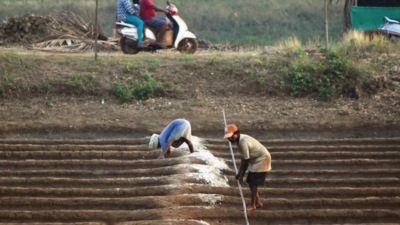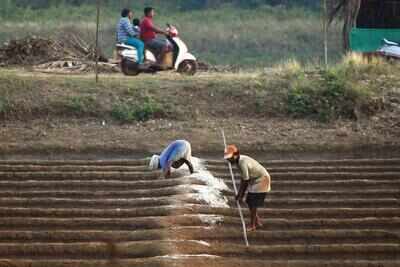Top Searches
Bad weather, labour travails rub salt in ailing industry’s wounds in Goa
PANAJI: Sparkling white piles of salt lying along the roadside are a pleasing sight for many, but despite the dry and hot weather conditions — most suitable for its production — the essential commodity is being sold at a premium of Rs 300-400 a tin.
Even as the mercury has been soaring since mid-February, the spillover effects of last season’s rain and fickle weather, as well as labour problems, seem to have hit the wobbling industry hard, producers told TOI.
At Batim, one of the hubs of salt production, vendors were quoting even Rs 400 per lat — a traditional measure — till a few days ago. During normal times, they would quote Rs 200 per lat.
Last year, cloudy weather persisted in phases. It also rained sporadically from January, and last April was the wettest in 85 years. In May, overcast skies crippled solar salt production, and salt had to be brought in from Karwar and other areas.
“The unseasonal rain every now and then kept dissolving our salt. In the end, the production was so meagre we couldn’t even store some for seeding,” said Maria Fernandes, a vendor near Addvatter (literally crossroads) junction in Batim.
Salt, or even dirty salt water, speeds up the salt formation process. “Newly-produced salt or old stock is required as seeding material. It provides a nucleus for the crystallisation process, and the salt crystals form faster due to seeding,” said Savita Kerkar, dean of Goa University’s school of biological sciences and biotechnology.
From the estuaries, sea water flows through bundhs to salt pans. “It is routed through primary, secondary, and tertiary ponds, all interconnected through small openings, and evaporation takes place at all stages,” said Kerkar, who has researched salt pans and salt pan bacteria for 33 years. She added that Batim salt is considered Goa’s best, with the best bacterial flora and over 20 minerals.
Another major factor behind the closure of 200-odd salt pans across Goa is the non-availability of labour to carry out the curing process. “With unseasonal rain slashing our profits, inputs on labour are further impacting the industry. I am the only one working the salt pan in this area,” said Joaquim Cabral, who owns a salt pan along the Ribandar causeway.
Many salt pans in the vast khazan in northwest Tiswadi have disappeared in recent years. Not far away, nearly a dozen salt pans have gone out of production. “Eight were reclaimed for development at Patto, while a few others along the Ribandar causeway have been submerged due to flooding,” said Jose Carminho Joao, attorney of the Morombi O Pequeno comunidade.
There were more saltpans towards Merces, Goa Velha, and Batim, but salt production has largely stopped due to a combination of factors related to cost inputs, changing lifestyles and weather conditions. TOI recently reported that “normal rainfall” is expected in Goa this month.
Even as the mercury has been soaring since mid-February, the spillover effects of last season’s rain and fickle weather, as well as labour problems, seem to have hit the wobbling industry hard, producers told TOI.
At Batim, one of the hubs of salt production, vendors were quoting even Rs 400 per lat — a traditional measure — till a few days ago. During normal times, they would quote Rs 200 per lat.
Last year, cloudy weather persisted in phases. It also rained sporadically from January, and last April was the wettest in 85 years. In May, overcast skies crippled solar salt production, and salt had to be brought in from Karwar and other areas.
“The unseasonal rain every now and then kept dissolving our salt. In the end, the production was so meagre we couldn’t even store some for seeding,” said Maria Fernandes, a vendor near Addvatter (literally crossroads) junction in Batim.
Salt, or even dirty salt water, speeds up the salt formation process. “Newly-produced salt or old stock is required as seeding material. It provides a nucleus for the crystallisation process, and the salt crystals form faster due to seeding,” said Savita Kerkar, dean of Goa University’s school of biological sciences and biotechnology.
From the estuaries, sea water flows through bundhs to salt pans. “It is routed through primary, secondary, and tertiary ponds, all interconnected through small openings, and evaporation takes place at all stages,” said Kerkar, who has researched salt pans and salt pan bacteria for 33 years. She added that Batim salt is considered Goa’s best, with the best bacterial flora and over 20 minerals.
Another major factor behind the closure of 200-odd salt pans across Goa is the non-availability of labour to carry out the curing process. “With unseasonal rain slashing our profits, inputs on labour are further impacting the industry. I am the only one working the salt pan in this area,” said Joaquim Cabral, who owns a salt pan along the Ribandar causeway.
Many salt pans in the vast khazan in northwest Tiswadi have disappeared in recent years. Not far away, nearly a dozen salt pans have gone out of production. “Eight were reclaimed for development at Patto, while a few others along the Ribandar causeway have been submerged due to flooding,” said Jose Carminho Joao, attorney of the Morombi O Pequeno comunidade.
There were more saltpans towards Merces, Goa Velha, and Batim, but salt production has largely stopped due to a combination of factors related to cost inputs, changing lifestyles and weather conditions. TOI recently reported that “normal rainfall” is expected in Goa this month.

About the Author
Paul FernandesPaul Fernandes, assistant editor (environment) at The Times of India, Goa, has more than two decades of experience behind him. He writes on social, environmental, heritage, archaeological and other issues. His hobbies are music, trekking, adventure and sports, especially football.
Start a Conversation
FOLLOW US ON SOCIAL MEDIA
FacebookTwitterInstagramKOO APPYOUTUBE











